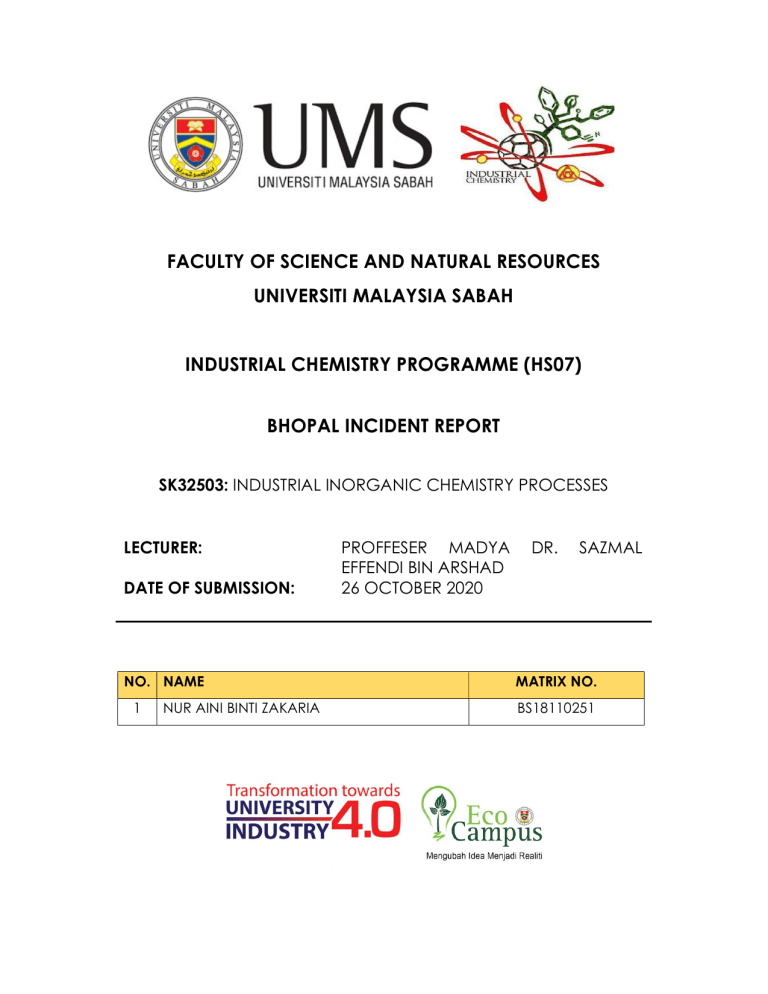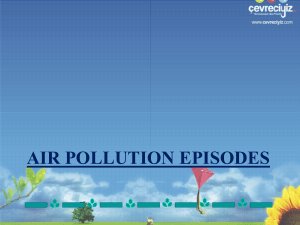
FACULTY OF SCIENCE AND NATURAL RESOURCES UNIVERSITI MALAYSIA SABAH INDUSTRIAL CHEMISTRY PROGRAMME (HS07) BHOPAL INCIDENT REPORT SK32503: INDUSTRIAL INORGANIC CHEMISTRY PROCESSES LECTURER: DATE OF SUBMISSION: NO. NAME 1 NUR AINI BINTI ZAKARIA PROFFESER MADYA EFFENDI BIN ARSHAD 26 OCTOBER 2020 DR. SAZMAL MATRIX NO. BS18110251 INTRODUCTION Bhopal incident was happened on the night of 2nd and 3rd December 1984. The incident considered as among the world’s worst industrial disaster and it is about the leaking of tons of the deadly gas methyl isocyanate (MIC) at a Union Carbide India Limited pesticide plant in Bhopal, Madhya Pradesh, India. The incident occurred when none of the 6-safety system designed contain such a leak were operational letting the gas to spread throughout the city of Bhopal. At least, 20,000 people have died, and more than 120,000 people still suffer from ailments caused by the accident and the subsequent pollution at the plant site. These ailments include blindness, extreme difficulty in breathing and gynaecological disorders. PROCESS DIAGRAM There are 5 main process areas on the site which are carbon monoxide production, phosgene manufacturing plant, methyl isocyanate plant, alpha naphthol plant and sevin plant. For the methyl isocyanate plant process, it was produced by reacting phosgene with methyl amie and separating out the MIC by distillation process while the liquid MIC was taken then pumped into the storage tank. MALFUNCTION IN THE SYSTEM The compound methyl isocyanate (MIC) was produced as an intermediate product in the process and a larges quantities of the compound were stored in the steel tank which had a lot of safety features to maintain the product in a stable form and safe since it is a n extremely toxic and unstable substance. However due to economic pressure, some of these safety features were abandoned in order to save money. The plant has two main safety devices which are scrubber and flare tower and both of it failed to operate on that day. The function of scrubber is neutralizing the gas with caustic soda while the flare tower is where the gas can be burnt-off. During that night when an employee was flushing a corroded pipe, multiple stopcocks failed and allowed water inadvertently entered the storage tank and caused an exothermic reaction to occur. Exposure to this water led the MIC boiled up and MIC vapour was expelled through the bursting disc vent. Since the scrubber and flare stack were not operating, therefore the MIC vapour was spread directly to the atmosphere. SUGGESTION TO AVOID THE DISASTER The tragedy of Bhopal showed that expanding industrialization in developing countries without concurrent evolution in safety regulation cause catastrophic consequences. Therefore, there are some step that could be taken to avoid from this kind of disaster to be happened again. The most important prerequisite for accident prevention is the top management commitment to safety. Accident prevention should not treat as an expensive add on facility, however, is must be an integral part of management and organizational objectives. Another suggestion is the local government clearly cannot allow the industrial facilities to be situated within the urban areas due to the evolution of the land use over time. Other than that, national governments and international agencies should focus on widely applicable techniques for corporate responsibility and incident prevention as much in the developing world context as in advanced industrial nations. Next, it is necessary to have an outline risk assessment to be formulated at the project feasibility phase for the purpose of containing planning consent. Plus, the leading part in the formulation of a detailed hazard operations or hazard analysis study on a completed installation need to be done by staff and should be used for safety management of day to day operations. REFERENCE B. Bowonder (17 Feb 2012). An analysis of the Bhopal accident. Retrieved from https://www.tandfonline.com/doi/pdf/10.1080/02688867.1987.9726622. Edward Broughton (February 2005). The Bhopal disaster and its aftermath: A review. Retrieved from https://www.researchgate.net/publication/7859596_The_Bhopal_disaster_and _its_aftermath_A_review.

